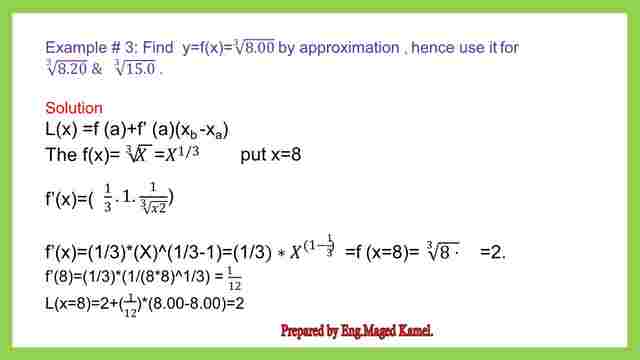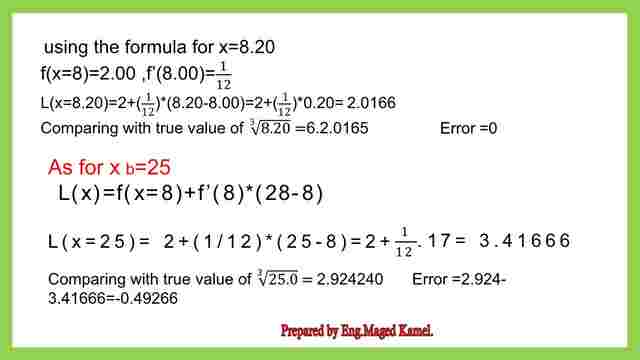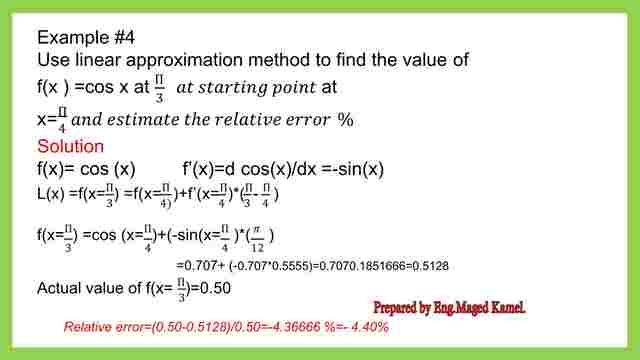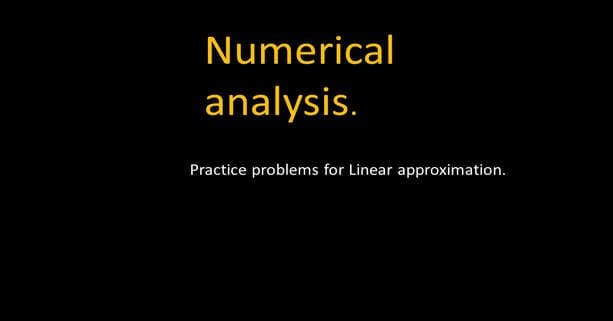Last Updated on March 21, 2024 by Maged kamel
Practice problems with linear approximation.
This is the first practice problem #3, it is required to find the approximate value of the third root of 8.
In Practice problem #3, it is required to get the approximate value of the third root of 8, also the third root of 8.20, and finally the third root of 25.00. Here are the steps:
Part 1 of Practice problem #3-Practice problems with linear approximation.
1-Our starting point is chosen to be a0=8.00, in the first case b0= 8.00.
2- The function value at x=8 will equal 2.00.
3-The differentiation of f(x)will be=1/3*(x^(1/3)-1)=1/3*x^(-2/3), the slope value at x=8, will be=(1/3)*(8)^(-2/3)=1/12.
4-Use the linear approximation expression and get L(x=8) =f(8)+(y’*(xb-xa), a is the starting point where x=8.00 and ending point=8.00, the term relates to the slope will be=0.
5- the linear approximation L(x=8)=2.00+(1/12)*(8.00-8.0))=2.00. 6-The exact value is the approximated value + error, the exact value is equal to 2.00, and the approximated value=2.00.

7- The error value=2-2=0.00. Refer to the previous slide image for more details.
Part 2 of Practice problem #3-Practice problems with linear approximation.
Solved example #3, it is required to get the approximate value of the third root of 8.20.
1-Our starting point is chosen to be a0=8.00, in the first case b0= 8.20.
2- The function value at x=8=2.00, this f(x=a).
3-The differentiation of f(x)will be=1/3*(x^(1/3)-1)=1/3*x^(-2/3), the slope value at x=8, will be=(1/3)*(8)^(-2/3)=(1/12).
4-Use the linear approximation expression and get L(x=8) =f(8)+(y’*(xb-xa), a is the starting point where x=8.00 and ending point=8.20.
5-L(x=8.20)=2.00+(1/12)*(8.20-8.0))=2.0166.ated value=2.00.
6-The exact value equal to the approximated value + error, the exact value is 2.01652, the approximated value=2.0166.
Part 3 of Practice problem #3-Practice problems with linear approximation.
In Part 3 of Practice problem#3, is required to get the approximate value of the third root of 25.0.
1-Our starting point is chosen to be a0=8, in this third case the value of b0= 25.
2- The function value at x=8=2.00, this f(x=a).
3-The differentiation of f(x)will be=1/3*(x^(1/3)-1)=1/3*x^(-2/3), the slope value at x=8, will be=(1/3)*(8)^(-2/3)=(1/12).
4-Use the linear approximation expression and get L(x=25.0) =f(8)+(y’*(xb-xa), a is the starting point where x=8.00 and ending point=25.
5- The linear approximated value at 8.2, will be written as L(x=8.20)=2.00+(1/12)*(25.0-8.0))=3.4166.
6-The exact value is the approximated value + error, the exact value is 2.92424, and the approximated value is 3.41666.
7- The error value=(2.92424-3.4166)=-0.49266.

Practice problem #4–Practice problems with linear approximation.
Practice problem #4, for linear approximation for the f(x)= cos(x) at initial point pi/4, it is required to estimate the linear approximation at x=pi/3. The solution can be done through the following steps:
1- We need to estimate the function value at the starting point a, which is= cos(Pi/4)=0.707.
2- Get the slope at x=pi/4 of the function, f'(cos(x))=-sin(x),when x=Pi/4.
3- Get the value of y’ at x=Pi/4, which is the starting point, it will be f'(x= Pi/4)=-0.707.
4-Use the linear approximation expression and get L(x=Pi/3) =f(Pi/4)+(y’*(xb-xa), a is the starting point where x=(Pi/4), while xb is the point for which we want to estimate the Y value which is =Pi/3.
5-L(x=Pi/3)=0.707+((-0.707)*(Pi/3-Pi/4))=0.5218.
6-The exact value= the approximated value + error, the exact value is cos(Pi/3)=0.50, the approximated value=0.5218.
7- The error value=0.50-0.5218=-0.0218.
8- For the error % divide by 100, then error%=0.0218%.

This is the pdf file used in the illustration of this post.
The next post is about the Newton-Raphson method. The method is another method for root finding.

